Islam in Europe: Difference between revisions
only 6% of russias population is islamic http://www.kommersant.ru/doc/1997068 |
|||
| Line 66: | Line 66: | ||
[[File:IslamInEurope.png|thumb|300px|right|Muslim-majority areas in Europe]] |
[[File:IslamInEurope.png|thumb|300px|right|Muslim-majority areas in Europe]] |
||
According to the German {{ill|de|Central Institute Islam Archive|Zentralinstitut Islam-Archiv-Deutschland}}, the total number of Muslims in Europe in 2007 was about 38 million (5.2%),<ref>http://www.pewforum.org/uploadedfiles/Topics/Demographics/Muslimpopulation.pdf, p. 25. Islam in Europe states 3.2% Muslims in European Union, but non-European Union countries (mainly Russia) harbour even more Muslims so percents go to about 5.2%.</ref> excluding [[Turkey]]. The total number of Muslims in the [[European Union]] in 2007 was about 16 million (3.2%).<ref name="islam.de">[http://islam.de/8368.php In Europa leben gegenwärtig knapp 53 Millionen Muslime]</ref> Approximately 9 million [[Turks in Europe|Turks are living in Europe]], excluding the [[Turkish people|Turkish]] population of [[Turkey]], which makes up the largest Muslim immigrant community in Europe.<ref name="Cole 2011 loc=92">{{citation |last=Cole|first=Jeffrey|year=2011|title=Ethnic Groups of Europe: An Encyclopedia|place=|publisher=ABC-CLIO|isbn=1-59884-302-8|page=367}}</ref> |
According to the German {{ill|de|Central Institute Islam Archive|Zentralinstitut Islam-Archiv-Deutschland}}, the total number of Muslims in Europe in 2007 was about 38 million (5.2%),<ref>http://www.pewforum.org/uploadedfiles/Topics/Demographics/Muslimpopulation.pdf, p. 25. Islam in Europe states 3.2% Muslims in European Union, but non-European Union countries (mainly Russia) harbour even more Muslims so percents go to about 5.2%.</ref> excluding [[Turkey]]. The total number of Muslims in the [[European Union]] in 2007 was about 16 million (3.2%).<ref name="islam.de">[http://islam.de/8368.php In Europa leben gegenwärtig knapp 53 Millionen Muslime]</ref> Approximately 9 million [[Turks in Europe|Turks are living in Europe]], excluding the [[Turkish people|Turkish]] population of [[Turkey]], which makes up the largest Muslim immigrant community in Europe.<ref name="Cole 2011 loc=92">{{citation |last=Cole|first=Jeffrey|year=2011|title=Ethnic Groups of Europe: An Encyclopedia|place=|publisher=ABC-CLIO|isbn=1-59884-302-8|page=367}}</ref> However the real number of Muslims in Europe is probably much lower as Western Sociologists tend to Exaggerate the Number of Muslims in Eastern Europe, for Example recent studies show that only 6% of the Russian population is Islamic, while traditional figures have estimates it at 20-30% [http://www.kommersant.ru/doc/1997068[ |
||
The Muslim population in Europe is extremely diverse with varied histories and origins. Today, the Muslim-majority regions of Europe are [[Albania]], [[Kosovo]], parts of [[Bosnia and Herzegovina]], and some [[Subdivisions of Russia|Russian regions]] in [[Northern Caucasus]] and the [[Volga]] region. The Muslim-dominated [[Sandžak]] [[Sanjak of Novi Pazar|of Novi Pazar]] is divided between Serbia and Montenegro. They consist predominantly of indigenous Europeans of the Muslim faith whose religious tradition dates back several hundred years. The [[List of countries spanning more than one continent|transcontinental]] countries of [[Turkey]], [[Azerbaijan]] and [[Kazakhstan]] also are Muslim majority. The Muslim population in Western Europe is composed primarily of peoples who arrived to the European continent in or after (1945), when France declared itself a country of immigration. Muslim emigration to metropolitan France surged during the [[Algerian War of Independence]]. In 1961, West German Government invited first [[Gastarbeiter]]s. Similar contracts were offered by Switzerland. The Muslim population tends to suffer [[Islamophobia]] all over Europe, although the perceptions and views of Muslims may vary.<ref>European Monitoring Centre on Racism and Xenophobia (2006): [http://fra.europa.eu/sites/default/files/fra_uploads/156-Manifestations_EN.pdf Muslims in the European Union. Discrimination and Islamophobia] Retrieved September 25, 2012</ref> |
The Muslim population in Europe is extremely diverse with varied histories and origins. Today, the Muslim-majority regions of Europe are [[Albania]], [[Kosovo]], parts of [[Bosnia and Herzegovina]], and some [[Subdivisions of Russia|Russian regions]] in [[Northern Caucasus]] and the [[Volga]] region. The Muslim-dominated [[Sandžak]] [[Sanjak of Novi Pazar|of Novi Pazar]] is divided between Serbia and Montenegro. They consist predominantly of indigenous Europeans of the Muslim faith whose religious tradition dates back several hundred years. The [[List of countries spanning more than one continent|transcontinental]] countries of [[Turkey]], [[Azerbaijan]] and [[Kazakhstan]] also are Muslim majority. The Muslim population in Western Europe is composed primarily of peoples who arrived to the European continent in or after (1945), when France declared itself a country of immigration. Muslim emigration to metropolitan France surged during the [[Algerian War of Independence]]. In 1961, West German Government invited first [[Gastarbeiter]]s. Similar contracts were offered by Switzerland. The Muslim population tends to suffer [[Islamophobia]] all over Europe, although the perceptions and views of Muslims may vary.<ref>European Monitoring Centre on Racism and Xenophobia (2006): [http://fra.europa.eu/sites/default/files/fra_uploads/156-Manifestations_EN.pdf Muslims in the European Union. Discrimination and Islamophobia] Retrieved September 25, 2012</ref> |
||
Revision as of 18:00, 14 February 2013
This article deals with the history and evolution of the presence of Islam in Europe.
History
Early history
Islam came to Europe in various ways, including through conquest. New research has uncovered a Böszörmény Muslim community in 12th century Hungary with roots in Muslim merchants in commerce with Asia over the Silk Road. Significant communities of Muslim Lipka Tatars lived throughout the Polish-Lithuanian Commonwealth, worshiping in small wooden Mosques and playing a key role in the history of Poland and Lithuania.[citation needed]
The Balkans, Russia and Ukraine

Muslim Arabs fought the Byzantine Empire soon after the establishment of Islam. The then Christian Syrian, Armenian, Egyptian and North African provinces of the Byzantine Empire were overrun. Soon after, Constantinople was besieged twice, once in a long blockade between 674 and 678, and once again between 717 and 718. However, the Byzantines successfully defended Constantinople and were able to re-establish control over much of Anatolia. This blocked further expansion of the Arab Caliphate towards the Balkans.
The Arab armies also conquered much of the Caucasus from the Turkic Khazars during the Khazar–Arab Wars, but the instability of the Umayyad Caliphate made a permanent occupation impossible. The Arab armies withdrew and Khazar independence was re-asserted. This also prevented Islamic expansion into Europe for some time. Nonetheless, many Khazars began converting to Islam, as is evidenced by the conflict between the Jewish convert aristocracy and common pagan, Christian, and Muslim masses of Khazaria. This would influence the conversion of significant numbers of Volga Bulgars to Islam before it became their state religion.
In 824 CE, Byzantine Crete fell to Arabs, who established an emirate on the island, which lasted until 960, when Nikephoros Phokas reconquered Crete for the Byzantines.
In the early 10th century, in what is now part of European Russia, the king of Volga Bulgaria, Almış, accepted Islam and established it as the state religion. Ibn Fadlan was dispatched by the Abbasid Caliph al-Muqtadir in 922/3 to establish relations and bring qadis and teachers of sharia to Volga Bulgaria, as well as to help build a fort and a mosque. Olga and her grandson Vladimir were the first Christian rulers of Russia. She converted to orthodox Christianity in 957 and Vladimir did the same in 988.[citation needed]
There are accounts of the trade connections between the Muslims and the Rus, apparently Vikings who made their way towards the Black Sea through Central Russia. On his way to Volga Bulgaria, Ibn Fadlan brought detailed reports of the Rus, claiming that some had converted to Islam. "They are very fond of pork and many of them who have assumed the path of Islam miss it very much." The Rus also relished their nabidh, a fermented drink Ibn Fadlan often mentioned as part of their daily fare.[1]
The Mongols began their conquest of Rus', Volga Bulgaria, and the Cuman-Kipchak Confederation (present day Russia and Ukraine) in the 13th century. After the Mongol empire split, the eastern European section became known as the Golden Horde. Despite the fact that they were not Muslim at the time, the western Mongols adopted Islam as their religion in the early 14th century under Berke Khan, and later Uzbeg Khan who established it as the official religion of the state. Much of the mostly Turkic-speaking population of the Horde, as well as the small Mongol aristocracy, were Islamized (if they were not already Muslim, such as the Volga Bulgars) and became known to Russians and Europeans as the Tatars. More than half[2] of the European portion of Russia and Ukraine, were under suzerainty of Muslim Tatars and Turks from the 13th to the 15th century. The Crimean Khanate became a vassal state of the Ottoman Empire in 1475 and subjugated what remained of the Great Horde by 1502. The Khanate of Kazan was conquered by Ivan the Terrible in 1552.
Balkans during the Ottoman Empire
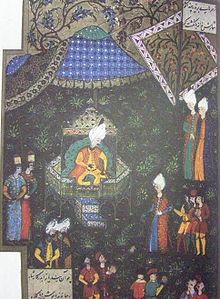
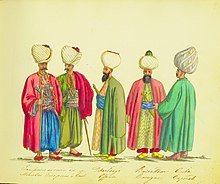
The Ottoman Empire began its expansion into Europe by taking the European portions of the Byzantine Empire in the 14th-15th centuries up until the 1453 capture of Constantinople, establishing Islam as the state religion in the region. The Ottoman Empire continued to stretch northwards, taking Hungary in the 16th century, and reaching as far north as the Podolia in the mid-17th century (Peace of Buczacz), by which time most of the Balkans was under Ottoman control. Ottoman expansion in Europe ended with their defeat in the Great Turkish War. In the Treaty of Karlowitz (1699), the Ottoman Empire lost most of its conquests in Central Europe. The Crimean Khanate was later annexed by Russia in 1783.[4] Over the centuries, the Ottoman Empire gradually lost almost all of its European territories, until its collapse in 1922, when the former empire was transformed into the nation of Turkey.
Between 1354 (when the Ottomans crossed into Europe at Gallipolli) and 1526, the Empire had conquered the territory of present day Greece, Bulgaria, Romania, Albania, Serbia, Macedonia, Montenegro, Bosnia and Hungary. The Empire laid siege to Vienna in 1683. The intervention of the Polish King broke the siege, and from then afterwards the Ottomans battled the Habsburg Emperors until 1699, when the Treaty of Karlowitz forced them to surrender Hungary, Croatia, and portions of present day Slovenia and Serbia. From 1699 to 1913, wars and insurrections pushed the Ottoman Empire further back until it reached the current European border of present-day Turkey.
For most of this period, the Ottoman retreats were accompanied by Muslim refugees from these province (in almost all cases converts from the previous subject populations), leaving few Muslim inhabitants in Hungary, Croatia, and the Transylvania region of present day Romania. Bulgaria remained under Ottoman rule until around 1878, and currently its population includes about 131,000 Muslims (2001 Census) (see Pomaks).
Bosnia was conquered by the Ottomans in 1463, and a large portion of the population converted to Islam in the first 200 years of Ottoman domination. By the time Austia-Hungary occupied Bosnia in 1878, the Habsburgs had shed the desire to re-Christianize new provinces. As a result, a sizable Muslim population in Bosnia survived into the 20th century. Albania and the Kosovo area remained under Ottoman rule until 1913. Previous to the Ottoman conquest, the northern Albanians were Roman Catholic and the southern Albanians were Christian Orthodox, but by 1913 the majority were Muslim. Apart from the effect of a lengthy period under Ottoman domination, many of the subject population were converted to Islam as a result of a deliberate move by the Ottomans as part of a policy of ensuring the loyalty of the population against a potential Venetian invasion. However, Islam was not spread by force in the areas under the control of the Ottoman Sultan according to Thomas Walker Arnold.[5] Rather Arnold explains Islam's spread by quoting a 17th century author who stated:
Meanwhile he (the Turk) wins (converts) by craft more than by force, and snatches away Christ by fraud out of the hearts of men. For the Turk, it is true, at the present time compels no country by violence to apostatise; but he uses other means whereby imperceptibly he roots out Christianity...[5]
Iberia and Southern France
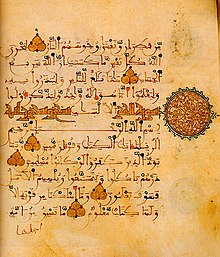
Muslim forays into Europe began shortly after the religion's inception, with a short lived invasion of Byzantine Sicily by a small Arab and Berber force that landed in 652. Islam gained its first foothold in continental Europe from 711 onward, with the Umayyad conquest of Hispania. The invaders named their land Al-Andalus, which expanded to include what is now Portugal and Spain except for the northern highlands of Asturias, Basque country, Navarra and few other places protected by mountain chains from southward invasions. Al-Andalus has been estimated to have had a Muslim majority by the 10th century.[6]: 42 This coincided with the La Convivencia period of the Iberian Peninsula as well as the Golden age of Jewish culture in Spain. Pelayo of Asturias began the Christian counter-offensive known as the Reconquista after the Battle of Covadonga in 722. Slowly, Spanish Christian forces regained control of the peninsula. By 1236, practically all that remained of Muslim Spain was the southern province of Granada.
In the 8th century, Muslim forces pushed beyond Spain into Aquitaine, in southern France, but suffered a temporary setback when defeated by Eudes, Duke of Aquitaine, at the Battle of Toulouse (721). In 725 Muslim forces captured Autun in France. The town would be the easternmost point of expansion of Umayyad forces into Europe; just seven years later in 732, the Umayyads would be forced to begin their withdrawal to al-Andalus after facing defeat at the Battle of Tours by Frankish King Charles Martel. From 719 to 759, Septimania was one of the five administrative areas of al-Andalus. The last Muslim forces were driven from France in 759, but maintained a presence, especially in Fraxinet all the way into Switzerland until the 10th c.[7] At the same time, Muslim forces managed to capture Sicily and portions of southern Italy, and even sacked Rome in 846 and later sacked Pisa in 1004.
Sicily
Sicily was gradually conquered by the Arabs and Berbers from 827 onward, and the Emirate of Sicily was established in 965. They held onto the region until their expulsion by the Normans in 1072.[8][9]
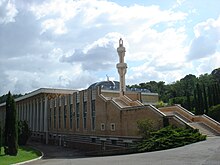
Cultural impact and Christian interaction
The Christian conquests of the Iberian peninsula and southern Italy helped to reintroduce ideas and concepts lost to the Western World after the fall of Rome in A.D. 476. Arab speaking Christian scholars saved influential pre-Christian texts and this coupled with the introduction of aspects of medieval Islamic culture (including the arts, agriculture, economics, philosophy, science and technology) assisted with fomenting conditions required for a rebirth of European thought and art (Renaissance). (See Latin translations of the 12th century and Islamic contributions to Medieval Europe for more information).
Muslim rule endured in the Emirate of Granada, from 1238 as a vassal state of the Christian Kingdom of Castile, until the completion of La Reconquista in 1492.[6]: 41 The Moriscos (Moorish in Spanish) were finally expelled from Spain between 1609 (Castile) and 1614 (rest of Spain), by Philip III during the Spanish Inquisition.
Throughout the 16th to 19th centuries, the Barbary States sent Barbary pirates to raid nearby parts of Europe in order to capture Christian slaves to sell at slave markets in the Arab World throughout the Renaissance period.[10][11] According to Robert Davis, from the 16th to 19th century, pirates captured 1 million to 1.25 million Europeans as slaves. These slaves were captured mainly from the crews of captured vessels[12] and from coastal villages in Spain and Portugal, and from farther places like Italy, France or England, the Netherlands, Ireland and even Iceland.[10]
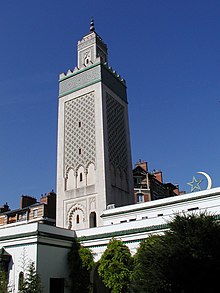
Cultural influences
Islam piqued interest among European scholars, setting off the movement of Orientalism. The founder of modern Islamic studies in Europe was Ignác Goldziher, who began studying Islam in the late 19th century. For instance, Sir Richard Francis Burton, 19th-century English explorer, scholar, and orientalist, and translator of 'The Arabian Nights' The Book of One Thousand and One Nights, disguised himself as a Pashtun and visited both Medina and Mecca during the Hajj, as described in his book The Pilgrimage to Al-Medinah and Meccah
Islamic architecture influenced European architecture in various ways (for example, the Türkischer Tempel synagogue in Vienna). During the 12th century Renaissance in Europe, Latin translations of Arabic texts were introduced. The Koran was also translated (for example, Lex Mahumet pseudoprophete).
Current population and its perception

According to the German de, the total number of Muslims in Europe in 2007 was about 38 million (5.2%),[13] excluding Turkey. The total number of Muslims in the European Union in 2007 was about 16 million (3.2%).[14] Approximately 9 million Turks are living in Europe, excluding the Turkish population of Turkey, which makes up the largest Muslim immigrant community in Europe.[15] However the real number of Muslims in Europe is probably much lower as Western Sociologists tend to Exaggerate the Number of Muslims in Eastern Europe, for Example recent studies show that only 6% of the Russian population is Islamic, while traditional figures have estimates it at 20-30% [http://www.kommersant.ru/doc/1997068[
The Muslim population in Europe is extremely diverse with varied histories and origins. Today, the Muslim-majority regions of Europe are Albania, Kosovo, parts of Bosnia and Herzegovina, and some Russian regions in Northern Caucasus and the Volga region. The Muslim-dominated Sandžak of Novi Pazar is divided between Serbia and Montenegro. They consist predominantly of indigenous Europeans of the Muslim faith whose religious tradition dates back several hundred years. The transcontinental countries of Turkey, Azerbaijan and Kazakhstan also are Muslim majority. The Muslim population in Western Europe is composed primarily of peoples who arrived to the European continent in or after (1945), when France declared itself a country of immigration. Muslim emigration to metropolitan France surged during the Algerian War of Independence. In 1961, West German Government invited first Gastarbeiters. Similar contracts were offered by Switzerland. The Muslim population tends to suffer Islamophobia all over Europe, although the perceptions and views of Muslims may vary.[16]
The UN High Commissioner for Refugees estimated that 70% of the people of Albania [17][18][19] are Muslim, 91% in Kosovo, and 30% of them in Macedonia are Muslim. Bosnia has a Muslim plurality. In transcontinental countries such as Turkey 99%, and 93% in Azerbaijan[20] of the population is Muslim respectively. Muslims also form about one sixth of the population of Montenegro. In Russia, Moscow is home to an estimated 1.5 million Muslims.[21][22][23]
Projections

Don Melvin wrote in 2004 that, excluding Russia, Europe's Muslim population will double by 2020. He also says that almost 85% of Europe's total population growth in 2005 was due to immigration in general.[22][25] Omer Taspinar predicted in 2001 that the Muslim population of Europe will nearly double by 2015, while the non-Muslim will shrink by 3.5%, if the higher Muslim birth rate persists.[26] In the UK, between 2001 and 2009, the Muslim population increased roughly 10 times faster than the rest of the population.[27]
A 2007 Center for Strategic and International Studies (CSIS) report argued that some Muslim population projections are overestimated.[28] Philip Jenkins of Penn State University estimates that by 2100, Muslims will compose about 25% of Europe's population. Jenkins states this figure does not take account divergent birthrates amongst Europe's immigrant Christians.[29] Other analysts are skeptical about the accuracy of the claimed Muslim population growth, stating that because many European countries do not ask a person's religion on official forms or in censuses, it has been difficult to obtain accurate estimates, and arguing that there has been a decrease in Muslim fertility rates in Morocco, the Netherlands and Turkey.[30] A Pew Research Center study, published in January 2011, forecast an increase of Muslims in European population from 6% in 2010 to 8% in 2030.[31] PEW also found that Muslim fertility rate in Europe would drop from 2.2 in 2010 to 2.0 in 2030. On the other hand, the non-Muslim fertility rate in Europe would increase from 1.5 in 2010 to 1.6 in 2030.[24]
See also
| Islam by country |
|---|
 |
|
|
- Discrimination in Europe
- Eurabia
- A Common Word Between Us and You
- European Islam
- Islam by country
- List of cities in the European Union by Muslim population
- Islamic dress in Europe
- Islamophobia
- Islamophobic incidents
- Persecution of Muslims
- Turks in Europe
- Women's rights and Islam
- Western Muslims
Organizations
- Catholic-Muslim Forum
- European Council for Fatwa and Research
- Muslim Council for Cooperation in Europe
- Muslim Executive of Belgium
References
- ^ Vikings in the East, Remarkable Eyewitness Accounts
- ^ "Encarta, Mongol Invasion of Russia". Archived from the original on 2009-10-31.
{{cite web}}: Unknown parameter|deadurl=ignored (|url-status=suggested) (help) - ^ http://media.hoover.org/sites/default/files/documents/Macedonia_and_the_Macedonians_Andrew_Rossos_63.pdf
- ^ Soldier Khan
- ^ a b The preaching of Islam: a history of the propagation of the Muslim faith By Sir Thomas Walker Arnold, pg. 135-144
- ^ a b Hourani, Albert, History of the Arab Peoples, Faber & Faber, 2002, ISBN 0-571-21591-2
- ^ Manfred, W: "International Journal of Middle East Studies", pages 59-79, Vol. 12, No. 1. Middle East Studies Association of North America, Aug 1980.
- ^ Roger II - Encyclopædia Britannica
- ^ Tracing The Norman Rulers of Sicily
- ^ a b "British Slaves on the Barbary Coast".
- ^ "Jefferson Versus the Muslim Pirates by Christopher Hitchens, City Journal Spring 2007".
- ^ Milton, G (2005) White Gold: The Extraordinary Story of Thomas Pellow And Islam's One Million White Slaves, Sceptre, London
- ^ http://www.pewforum.org/uploadedfiles/Topics/Demographics/Muslimpopulation.pdf, p. 25. Islam in Europe states 3.2% Muslims in European Union, but non-European Union countries (mainly Russia) harbour even more Muslims so percents go to about 5.2%.
- ^ In Europa leben gegenwärtig knapp 53 Millionen Muslime
- ^ Cole, Jeffrey (2011), Ethnic Groups of Europe: An Encyclopedia, ABC-CLIO, p. 367, ISBN 1-59884-302-8
- ^ European Monitoring Centre on Racism and Xenophobia (2006): Muslims in the European Union. Discrimination and Islamophobia Retrieved September 25, 2012
- ^ Religiousfreedom.lib.virginia.edu
- ^ Religiousintelligence.co.uk
- ^ "Albania". Religious Intelligence. United States Department of State. Retrieved 2008-07-27.
{{cite web}}: Cite has empty unknown parameter:|coauthors=(help) - ^ "Embassy of the Republic of Kazakhstan in the UK, Country Profile 2007, p.4" (PDF). Retrieved 2007-06-21.
- ^ The rise of Russian Muslims worries Orthodox Church, The Times, 5 August 2005
- ^ a b Don Melvin, Europe works to assimilate Muslims, Atlanta Journal Constitution, 2004-12-17, Template:Wayback
- ^ Tolerance and fear collide in the Netherlands, UNHCR, Refugees Magazine, Issue 135 (New Europe)
- ^ a b "The Future of the Global Muslim Population, Region:Europe". Pew Research Center. 2011-01-27.
- ^ Migration Information Source - Europe: Population and Migration in 2005
- ^ Omer Taspinar, Europe's Muslim Street, Brookings Institution, march 2003
- ^ Muslim population 'rising 10 times faster than rest of society' January 30, 2009, Richard Kerbaj, The Sunday Times
- ^ Esther Pan, Europe: Integrating Islam, Council on Foreign Relations, 2005-07-13
- ^ Philip Jenkins, Demographics, Religion, and the Future of Europe, Orbis: A Journal of World Affairs, vol. 50, no. 3, pp. 533, summer 2006
- ^ Mary Mederios Kent, Do Muslims have more children than other women in western Europe?, Population Reference Bureau, February 2008, Simon Kuper, Head count belies vision of ‘Eurabia’, Financial Times, 19 August 2007, Doug Saunders, The 'Eurabia' myth deserves a debunking, The Globe and Mail, 20 September 2008, Islam and demography: A waxing crescent, The Economist, 27 January 2011
- ^ Pewforum.org
Further reading
- Ghodsee, Kristen (2009). Muslim Lives in Eastern Europe: Gender, Ethnicity and the Transformation of Islam in Postsocialist Bulgaria. Princeton: Princeton University Press. ISBN 978-0-691-13955-5.
External links
- For Muslim Minorities, it is Possible to Endorse Political Liberalism, But This is not Enough
- BBC News: Muslims in Europe
- Khabrein.info: Barroso: Islam is part of Europe
- 2010 World Muslim Population by Dr. Houssain Kettani.
- Euro-Islam Website Coordinator Jocelyne Cesari, Harvard University and CNRS-GSRL, Paris
- Asabiyya: Re-Interpreting Value Change in Globalized Societies
- Why Europe has to offer a better deal towards its Muslim communities. A quantitative analysis of open international data
- Köchler, Hans, Muslim-Christian Ties in Europe: Past, Present and Future, 1996
